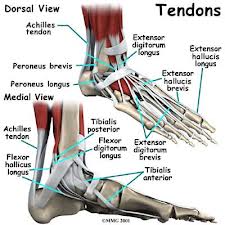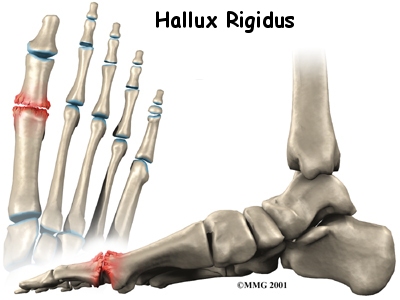Foot injuries are not isolated to runners or other athletes, they can develop in any one. Foot injuries can consist of sprains, fractures, stress fractures, joint inflammation or tendon injuries and consequences of instability. Individuals putting on several miles a day tend to exacerbate any any instability, this can cause inflammation. The repetitive motion and micro trauma can turn an everyday activity into a painful experience.
Tendon Injuries

Tendons are structures that connect bones to muscles. Tendons are responsible for creating motion across a joint commonly referred to as extension and flexion. Sheaths containing synovial fluid help to lubricate and minimize wear. Check out the Tendon Pain Page for more information on tendon injuries and tendon pain
Joint Inflammation

There are many joints in the feet. Inflammation can attack any of the joints in the feet though the most common location is the 1st metatarsalphalangeal joint (MTPJ). The 1st MTPJ deals with a tremendous amount of stress through daily activity and strenuous exercise. Some conditions may be related to gout, pseudogout, arthritis, or misalignment of the joint. Orthotics can be helpful in controlling the cause of the inflammation.
Stress Fractures
Stress fractures occur when repetitive microtruama to a bone occurs faster than a bone can rebuild. Bones are constantly rebuilding and removing cells to maintain the overall integrity of our bones. The cells responsible for bone resorption are called osteoclasts and the cells responsible for building bone are called osteoblasts, in proper balance the bones maintain structural integrity. Stress tends to increase the damage bone cells causing resorption, when the building of bone is not matched stress fractures occur.
What causes stress fractures?
Structural imbalances, metabolic conditions, and nutritional deficiencies are the number one causes of stress fractures. In many cases it can be a combination of the these conditions.
The most common location of stress fractures in the foot is the second metatarsal, however they can occur in any bone. The second metatarsal in particularly vulnerable due to its extended length. In most peoples feet the second metatarsal is longer than the other metatarsals.
Diagnosing Stress Fractures
Stress fractures are notoriously difficult to diagnose. In the early stages, a very faint line is all that is present, this faint line can be confused with vessel marks in the bone or just overlooked all together. At 2 weeks the bone starts to display signs of bone heeling evident by fluffy bone growth around the fracture site called callus formation. When the callus formation is visible a stress fracture is much easier to diagnose. It is uncertain if there is a stress fracture, an MRI, CT, or bone scan can be done, these radiology studies make it very ease to identify any abnormalities in the bone.
Stress Fracture Treatment
Stress fractures are fractures, and treated as such. It is important to stop all stresses on the bone and surrounding bones. Bones do not heel well when there is motion across a fracture site, walking boots with a rigid sole, casting, and non weight bearing are acceptable, however I prefer a cast and crutches. It has been my experience, people who develop stress fractures have a tendency to be rather stubborn and continue to over use the extremity.
Metabolic conditions must be addressed. Hyperthyroidism, osteoporosis, and decreased estrogen levels are common examples of metabolic conditions contributing to stress fractures and weakened bones. Women should be screened if presenting with a stress fracture.





